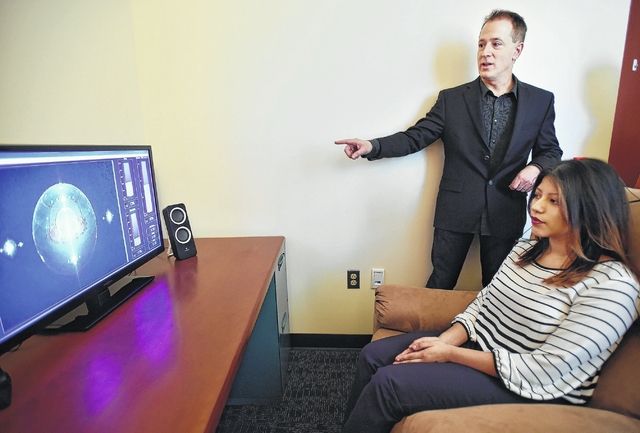Click here to subscribe today or Login.
WILKES-BARRE — The moniker is David Delight and, no, that’s not a Chippendale dancer’s stage name. Delight can calm your anxiety in 20 minutes — even put you to sleep — once you don headphones and goggles, all without saying a word.
Yet most people would consider the newcomer at Wilkes University far from boring. In fact, Professor Ed Schicatano gets pretty darn excited when he talks about Delight, so much so one wonders if he could benefit from a session.
The David Delight Plus is an electronic box sold by a corporation called Mind Alive. It is the fastest-working of three high-tech brain training gizmos Wilkes unveiled Thursday during an open house of the NeuroTraining and Research Center. And Schicatano, an associate professor of psychology, got so psyched about the new center he busted a gut setting it up.
Seriously. In explaining how the center became a reality thanks to fierce dedication of students, faculty and administration, Schicatano related his own efforts to help move desks and shelves into suite of rooms at Breiseth Hall. “I got a hernia,” he grinned.
Along with the David Delight — quick to calm with tones and light flashes in scientifically tested frequencies — the center also has a biofeedback room and and two neurotraining rooms. Both boast computers that respond to physical signals. In the case of biofeedback, that would be heart rate and blood pressure; in neurotraining, it’s brain waves measured with electrodes stuck to your cranium.
Lower your heart rate or blood pressure by calming down and the biofeedback screen rewards you with some positive image, like advancing a ship through space. Likewise, generate the type of brainwaves associated with calm or focus and the neurotraining screen does the same.
Student Government President Anthony Fanucci said the center can be used “to help students calm down and focus for an exam.” He grinned nervously at the crowd gathered for the ribbon cutting. “Which I could kind of use right now,” he added.
The neurotraining suite occupies rooms emptied when the business school moved. Wilkes President Patrick Leahy framed the facility in context of his larger, oft-cited goal “to create one of the finest small universities in the country.” “You can’t find a center like this in some of those big institutions,” he said.
At no cost, students and staff can use the equipment for both short- and long-term benefit. The effects of the David Delight fade fairly quickly, Schicatano said, while a few months on the neurotraining computer three times a week can help a person make long-lasting changes in ability to calm on demand.
The screen images of spheres turning, piloting a space ship or soaring along in a hot air balloon may look like video game fodder, but Schicatano noted the idea of neuroplasticity — meaning the brain can be changed even in adults — has gained a lot of scientific support. The American Academy of Pediatrics endorses neurofeedback as a treatment for attention deficit disorder.





